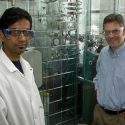UW researchers focus on food-borne illnesses
The battle over bad bugs in the food supply is intensifying at UW–Madison, with a new faculty hiring effort focused on the growing worldwide concern about food-borne pathogens.
Michael Pariza, director of Food Research Institute and Chair of the department of Food Microbiology and Toxicology, says the United States has seen a sharp rise in food-safety threats in the past half-century. Prior to 1950, only three disease-causing pathogens were known to be a concern in food; today, public health officials are trying to cope with nearly a dozen different classes of health threats.
“We have become much better at identifying what pathogens are causing what problems in people,” says Pariza. “But there are newly emerging pathogens that were not known 20 years ago as well as problems with enhanced antibiotic resistance among some of the traditional food-borne pathogens.”
For example, the bacterium E. coli O157:H7 emerged as a problem about a decade ago and today is the cause of nearly 75,000 infections and some deaths each year in the United States. A new strain of Salmonella that emerged in Europe in the 1990s appears resistant to many antibiotics and is more lethal than the common forms of Salmonella. And Listeria monocytogenes, which grows at refrigerator temperatures that were previously thought to inhibit pathogen growth, is now known to cause foodborne illness that can sometimes lead to death.
Even as research efforts increase and food-safety technology improves, Pariza says, the goal of preventing food-borne illnesses remains difficult in part because our food supply is now global. The scope of the problem might surprise people: A 1999 study by scientists at the Centers for Disease Control estimated that food-borne pathogens cause 76 million illnesses, 325,000 hospitalizations, and 5,000 deaths in the U.S. each year.
Against this backdrop, Pariza has been working to increase the Food Research Institute’s emphasis on emerging pathogens through the UW–Madison strategic hiring program. So far, the hiring effort has brought three new professors on board this year and an offer is pending with a fourth individual.
“The hiring program increases the depth of expertise at the institute and builds on some areas where Wisconsin could be a world leader,” he says. “It is particularly important for us to do this, given that agriculture is such an important component of Wisconsin’s economy.”
The new faculty hires include JaeHyuk Yu, a Ph.D. graduate of UW–Madison who arrived on campus in July from a previous senior research position with the fungal genomics group at Cereon Corporation; Nancy Keller, recruited from Texas A&M University, who will begin here next semester; and Frank Denes, a scientist with UW–Madison’s Center for Plasma-Aided Engineering, who will join the program in December.
Yu and Keller are world experts on mycotoxins, highly toxic substances produced by certain molds. Mycotoxins can be particularly serious when crops are stressed by drought (as happened in Wisconsin in 1988) or excessive moisture (as happened in Wisconsin in 1993). These episodes led to billion-dollar losses for farmers due to reduced crop yields and contaminated grain which had to be discarded. Livestock that were inadvertantly fed contaminated grain became ill or died, causing additional loss.
There was also concern over the possibility that mycotoxins in contaminated cow feed could carry over to milk, obviously a serious issue for Wisconsin dairy farmers. Pariza says new mycotoxins are being identified all the time.
Denes is working in the new field of food safety engineering. Through his work in plasma-aided engineering, Denes has developed surface treatments for food processing equipment that could make the equipment resistant to bacteria. He has also developed methods of plasma-treating the surfaces of seeds to increase disease resistance in crops. Plasma-aided engineering is the use of electrically charged particles to alter the surface properties of materials.
“I see (Denes’) work being the focal point of a whole new field of food safety engineering, which is something most other universities aren’t even thinking about,” Pariza says.
A fourth hire will be in the field of immunology, Pariza says, and the researcher will focus on host-parasite relationships in food-borne illnesses.
Solving food-related illnesses with technology is far from a black and white issue, Pariza adds, since some of the solutions have faced strong public resistance. For example, irradiation of meat products might be the single best solution for killing E. coli in hamburger, but retailers and some consumers have been unwilling to accept irradiated products. Genetic engineering is another potential pathway to reducing food safety problems, but it is even more politically charged. Nonetheless both of these approaches enjoy wide support within the scientific community, he says .
The food safety initiative is one of more than 30 new faculty hiring areas approved under UW–Madison’s two-year-old strategic hiring program, also known on campus as cluster hiring. The program is encouraging new interdisciplinary approaches to teaching and research that are built around emerging fields of knowledge.
Strategic hiring is a key goal of the Madison Initiative, a four-year, $97 million investment plan that is helping the university chart its future.
Tags: biosciences, research



